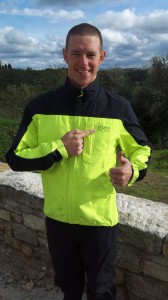Time for the third round of reviewing our gear and equipment! This week I’m discussing some of our clothing items and relevant accessories. In the previous weeks I reviewed the bikes and their accessories, as well as the bulk of our camping gear. Please note: there is almost no way for me to review every single item we had with us. Many small items were tucked deep into our panniers, and I’m really focusing on major items in these posts. However, if there’s something we haven’t addressed that you’re insatiably curious about, just post a comment or shoot us an e-mail, and we’ll be happy to answer!
Also, as an introduction to our classification, I’m including this same explanation that I used the past two posts:
As the Tour was coming to an end, I began mentally assessing our gear, thinking ahead to the next season when we will have income… and we’ll be able to begin replacing some of our more heavily used items. I generally created three categories into which all our things would fit:
1—Going strong, will continue to use (example: our bicycles)
2—Has seen better days, but still useable; replacement not a priority (example: our cookware)
3—Should probably be thrown away immediately (example: our cycling shorts)
So let’s get started!
Cycling shorts: Various brands (Pearl Izumi, Louis Garneau, Bellwether, etc.)
Status: Throw them away!
Recommendation: YES
It might seem a contradiction to you that I just said we should throw these shorts away, and yet, I recommend them. But I can honestly testify—there is no pair of cycling shorts in the world that is made to survive what we put ours through. UV damage alone will destroy them, not to mention lots of sweat and movement and sitting on the ground. Some of our shorts were the really nice, expensive kind. They wore out just like the mid-range ones did.
Now let’s take a moment to briefly address how cycling shorts deteriorate. It starts with a decline in stretchiness. Good spandex should be snug and kind of hold itself in place. When the shorts stop gripping your skin, when they just don’t seem to have the same tightness… that’s when you know the decay has begun. After this stage, the shorts begin flaking, almost as though they have a chronic case of dandruff. What’s really happening here is the breakdown of the Lycra. Once this stage begins, the trend is irreversible. Now it’s just a matter of time before they reach the final stage, which is embarrassing sagginess. At this point, elasticity is a thing of the past. The only hope for these shorts is to cover them up with what we call “courtesy gear” (because it’s a courtesy to everyone else for us to wear something over them). But might I add that throughout this entire process, the actual chamois pad (that acts as a cushion) is actually still in great shape. And thus we continued with them. If we could make it work, well, we made it work.
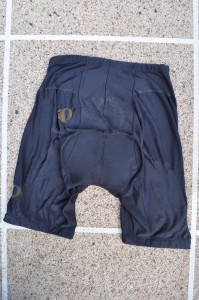
It’s hard to understand just how terrible these shorts look when they’re not on… but believe me, you’d rather not see that picture anyway. But you can see a lot of the degradation even here.
Dave had one pair of Louis Garneau shorts that somehow defied deterioration. He had those shorts for a solid year and a half before we left, then wore them regularly throughout the Tour. And somehow, amazingly, those shorts still look great (that is, if you’re into spandex shorts on a man).The model information is long lost on the tags, but I’ll tell you, we’d buy another pair of those in a heartbeat! We think they held up so well because they had a lining on the inside of the legs. So even if the outside material began to lose elasticity, the inside was spared from the UV aspect of damage, and thus they seemed to hold up significantly better.
By the way, though most of our shorts look terrible at this point, we have not brought ourselves to throw them away. We are holding out on replacing any gear until we have steady income, and so we’ve decided to just make do for now.
One more thing… You should know that not all touring cyclists wear legitimate cycling clothes, like the padded shorts or the snugly fitted jerseys. We met people wearing cargo shorts, sweatpants, tank tops, long-sleeve button-down shirts… and lots in between. Basically, you should wear whatever is most comfortable to YOU! We opted for maximum comfort while actually cycling. That meant we sacrificed some comfort if we had to get off and do much walking around, like going on a hike or even daily trips to the grocery store or market. Turns out, cycling shorts are not the greatest for that. But overall, we were pleased with our decision to actually wear the legitimate Lycra shorts all the time. Everyone’s different, though! You should just experiment to see what works for you.
Cycling Jerseys: Various brands (Bellwether, Nashbar, etc.)
Status: Seen better days
Recommendation: YES
Again, like the shorts, not all cyclists wear legitimate “cycling jerseys.” After all, they are more typically designed for people who are riding for the sake of speed, meaning they tend to be more tight-fitting. Dave had a nice mix of looser and tighter ones, while mine were all about medium tightness. If I could go back, I would opt for all shirts that fit me more loosely. But by the time I figured out that was my preference, we were well into the trip and I was doing fine with what I had. As for the actual condition of these shirts, they did great. The only real sign of wear is the significant fading on the back (since that part of the shirt was more consistently exposed to the sun).

Here you can begin to see the fading that affected our jerseys… note Dave’s right shoulder. The entire back of his jersey is also that color–which is not anywhere close to the red it started as. The backs faded because of their constant exposure to sun while we were cycling, while the fronts were actually mostly protected by our bodies.
Cycling Socks: Various brands (SmartWool, REI, etc.)
Status: Seen better days
Recommendation: YES
Well, it’s hard to even review our socks, because we only finished with a few of the ones that began the journey with us. Similar to other clothing items, I think no one is really out there designing socks that are made to withstand this kind of use. We lost a few pair to laundry services, someone stole a set of Dave’s off a clothesline in Honduras (you have to ask WHY they would want THOSE!), and we had to stitch up some holes in the toes from time to time. So we don’t have a specific brand recommendation, but we would certainly recommend buying the cycling-specific socks made of synthetic material. The cotton kind will literally just crumble on you after a certain amount of time!
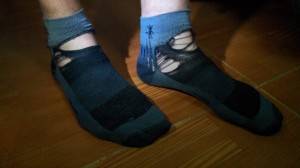
To be fair, Dave had used these socks before the Tour as well. He kept wearing them in this state for months before they were finally declared dead!
“Normal” Clothes: Various brands, but mostly from REI
Status: Seen better days
Recommendation: YES
Since we wore cycling-specific apparel while actually riding, we made sure to bring along a stash of “normal” clothes for tourist stops, evenings out, and social events. We tried to select versatile clothes, and both of us carried a fleece that we used both for riding and for other activities. I carried a dress for special occasions, but usually the “special” thing going on was a big laundry load, and I would wear my dress while everything else was in the wash! I did enjoy having it though on several occasions when we went to church, for nicer dinners out, and even just for fun. Honestly, it really helped me feel more feminine to wear my dress around every now and again! Dave had a pair of convertible cargo pants/shorts (from Bass Pro Shops) that he loved, and a blue button-down shirt with sleeves that rolled up and down (from REI). He got great use out of all of those. I also had a couple of solid shirts from Wal-Mart that I would wear with my khaki North Face pants, or I would wear them to sleep in. Basically, we carried a few staple items that we could mix and match and make work in a variety of situations. Besides some slight fading, Dave’s pants and shirt are going strong. My plain Wal-Mart shirts are a bit threadbare, and my North Face pants had several tears and spots of significant wear. We were pleased overall with how well our “normal” clothes held up over the course of the trip.

Sporting our “normal” clothes for a nice evening out to celebrate our fourth anniversary in Bangkok!
GoreTex Rain Jackets and Pants
Status: Going strong
Recommendation: YES
As we mentioned in a previous blog post (LINK), we replaced our rain jackets and pants after about a year on the road. The first ones were officially no longer waterproof. We sprung for the high-dollar GoreTex replacements, and we didn’t regret it. These lightweight jackets and pants not only proved to be better against rain (though in a true, all-out downpour, we’ve not found anything that will keep you 100 percent dry), they are also more compact, which we appreciated while packing up our often-crowded panniers. So even though GoreTex is a huge investment, we say it’s worth it.
Shimano Cycling Shoes with SPD Clips
Status: Throw them away!
Recommendation: YES
We absolutely loved wearing the clip-in cycling shoes, though many touring cyclists prefer to wear normal running shoes or hiking boots. We even met a girl who would wear nothing but flip flops! We preferred the increase in efficiency we got from having our feet actually attached to the pedal. It can be an adjustment at first (and that adjustment usually involves a few “tipping over” kind of falls). But once you get used to riding that way, it actually feels more natural than having on regular shoes! At this point with our shoes, the cleats (that actually hold the clip into the pedal) and the shoes themselves are completely worn out. Again, as I mentioned before, we haven’t actually thrown anything away, though we probably should have thrown these away first. It’s just that these shoes are no small investment, and we’re holding out on our upgrade until we can afford to do it well. On my shoes especially, the cleat is so worn out that if I really get to pedaling hard, my right shoe will just kind of fly out of the pedal, because there’s not enough of the cleat to hold it in its place.
Both of our shoes have holes and rips in them, simply from wear. During the last six months of the Tour, our shoes also began to feel more uncomfortable. They were no longer true in form to their original design. So on really long days, our feet would hurt even after we quit riding. And I got to where I wouldn’t even do a quick grocery run without changing my shoes because my cycling shoes had become so uncomfortable to walk around in. But we feel that ultimately, these shoes held up well for the 22,900 miles we pedaled in them.
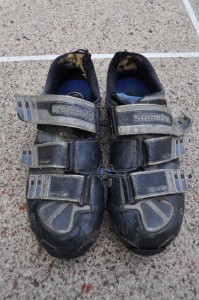
You can see how the backs of the shoes are worn out, and you can barely see the rip that spans from in between the Velcro straps all the way to the sole of the shoe on the one on the right. They’ve been through it!
Keen Newport Sandals
Status: Seen better days
Recommendation: YES!
We loved these versatile, closed-toe sandals. We wore these shoes for every occasion on our tour when we were not actually cycling… and considering the kind of wear that we put on them, they are still doing quite well. My pair of shoes has some significant degradation of the back strap that will eventually cause them to fail, but at least for now, they’re still useable. In the summer, these shoes are great to wear as sandals, and in the winter, we would just put on socks underneath, which you barely noticed if we were wearing pants (and we usually were). It’s not like we were trying to make a fashion statement on this trip anyway! So we highly recommend these shoes, both for comfort and durability.
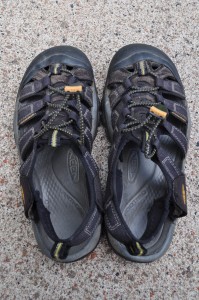
You can see how the backstrap has come loose on the right shoe, but altogether, these shoes were perfect for our touring lifestyle.
Well, as I said before, we certainly haven’t reviewed here every single thing we had along with us. Feel free to email us with questions or post a comment. And as promised last week, I’ll soon be doing a post with some details of some of the less glamorous items we brought along with us, like what all we included in our kitchen and what tools we carried. But I don’t think that will be next week…. I think first we’ll need a little break from all the gear talk!

